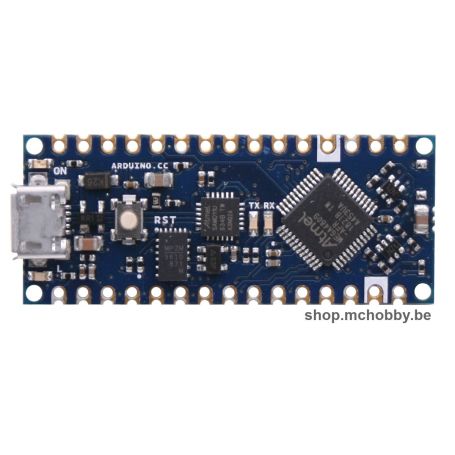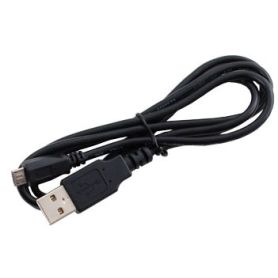Arduino Nano Every
- 48Kb of Flash
- 6Kb of SRAM
- ATmega 4809 @ 20 MHz
- EEProm: 256 bytes
- Arduino Nano form Factor
Payments are secured by LyraCollect, a French payment collection company.
It is possible to delivered to your home, to a pick-up point or picked up by appointment at MCHobby
We prepare, pack and ship your orders with great respect and care.
Arduino Nano Every, the right successor of the Arduino Nano
Arduino Nano has been very popular in many projects... and it has been a pitty to grab an official one this last year. Thankfully Nano Every is right there :-) ! Nano Every is even more powerful!
Nano Every is a board having the same footprint than the classical Nano (Arduino Nano) board, the so loved Arduino Nano.
Ass the classic Arduino Nano, the Nano Every offers a very small size with a robust and powerful Arduino development environment.
Nano Every can be programmed with Arduino IDE running on a PC (or the online version) and you can start your first projet in minutes... it would be the perfect fellow for the everyday projects.
The Arduino Nano Every is propeled by a powerful Atmel ATMega4809 microcontroler with all the good features required for Arduino Prototyping. It can be used with PinHeader on a breadboard or a perfboard -OR- the board soldered as a SMD component on your board (SMD surface mounted device).
The ATMega4809 processor if an ARM Cortex M0+ SAMD11 offering an impressive power for its size and also including a native USB support directly from the microcontroler.
The advanced user would also appreciate the extra possibility of programming the SA%D11 without Arduino IDE.
For more information on the Arduino Nano Every, do not hesitate to check the official Arduino Nano Every d'Arduino.CC page
Content
For each ordern you will receive the Arduino Nano Every and two sections of connector (PinHeader). The connector can be soldered on the board to plug the Nano Every on a breadboard or prototyping board.
Détails techniques
The Nano Every is more powerful than an Arduino UNO
- 48Kb of Flash to store the code
- 6Kb of SRAM to store variable
- ATmega4809 @ 20 MHz
- EEProm: 256bytes
- Arduino Nano form Factor
The 2 x 15 pins connector offer many features like GPIO, Analog input, PWM, SPI, UART, I2C.
| #Pin |
Arduino |
Type of |
Description |
| 1 | D13 | Digital | SPI SCK, GPIO |
| 2 | +3V3 | Power Out | Internally generated power output to external devices |
| 3 | AREF | Analog | Analog Reference; can be used as GPIO |
| 4 | A0 | Analog | ADC in; can be used as GPIO |
| 5 | A1 | Analog | ADC in; can be used as GPIO |
| 6 | A2 | Analog | ADC in; can be used as GPIO |
| 7 | A3 | Analog | ADC in; can be used as GPIO |
| 8 | A4 - SDA | Analog | ADC in; I2C SDA; Can be used as GPIO |
| 9 | A5 - SCL | Analog | ADC in; I2C SCL; Can be used as GPIO |
| 10 | A6 | Analog | ADC in; can be used as GPIO |
| 11 | A7 | Analog | ADC in; can be used as GPIO |
| 12 | +5V | Power Out | Internally generated power output to external devices |
| 13 | RST | Digital In | Active low reset input (duplicate of pin 18) |
| 14 | GND | Power | Power Ground |
| 15 | VIN | Power In | Vin Power input |
| 16 | TX | Digital | USART TX; can be used as GPIO |
| 17 | RX | Digital | USART RX; can be used as GPIO |
| 18 | RST | Digital | Active low reset input (duplicate of pin 13) |
| 19 | GND | Power | Power Ground |
| 20 | D2 | Digital | GPIO |
| 21 | D3 - PWM | Digital | GPIO; can be used as PWM |
| 22 | D4 | Digital | GPIO |
| 23 | D5 - PWM | Digital | GPIO; can be used as PWM |
| 24 | D6 - PWM | Digital | GPIO; can be used as PWM |
| 25 | D7 | Digital | GPIO |
| 26 | D8 | Digital | GPIO |
| 27 | D9 - PWM | Digital | GPIO; can be used as PWM |
| 28 | D10 - PWM | Digital | GPIO; can be used as PWM |
| 29 | D11 - MOSI | Digital | SPI MOSI; can be used as GPIO |
| 30 | D12 - MISO | Digital | SPI MISO; can be used as GPIO |









